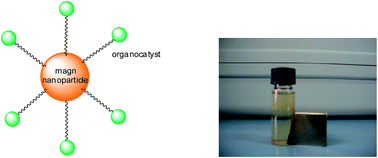Magnetic nanoparticle-supported organocatalysts – an efficient way of recycling and reuse
Abstract
Recycling of organocatalysts is an important aspect in green chemistry. Several techniques have been applied to address this issue ranging from traditional separation techniques (extraction, chromatography) to immobilization on solid supports. Magnetic separation, i.e. attraction of the catalyst by an external magnet and decantation of the supernatant appeared as a new way for separation of organocatalysts omitting problems connected to filtration when solid supported catalysts are used. In this publication, the state of the art of magnetic nanoparticle-supported organocatalysts is reviewed demonstrating a wide range of applications but at the same time hitherto unaddressed fields awaiting future exploration are discussed.


 Please wait while we load your content...
Please wait while we load your content...